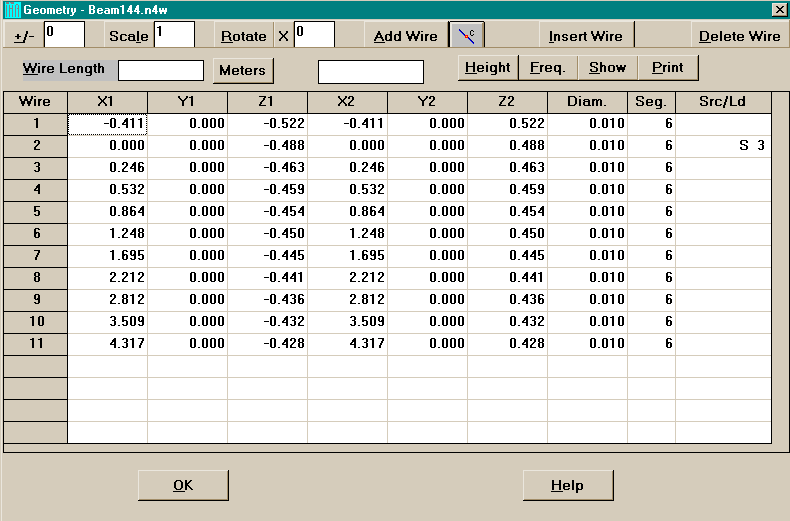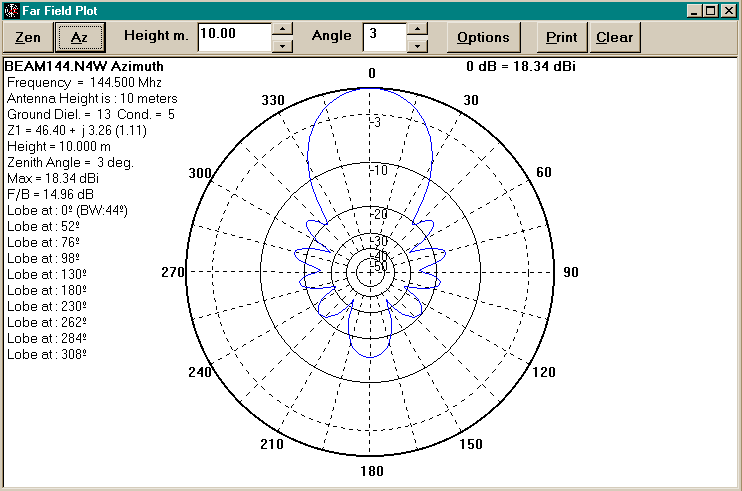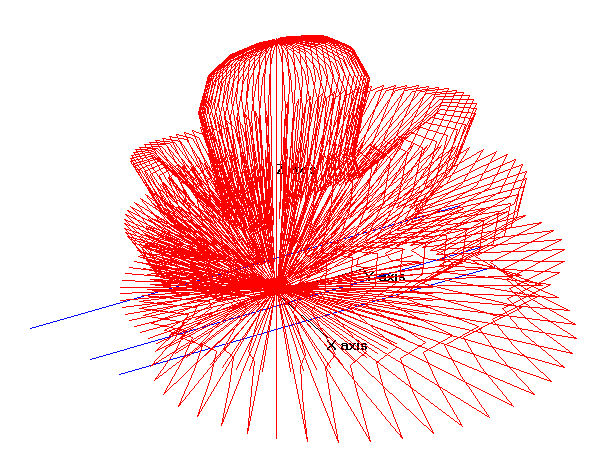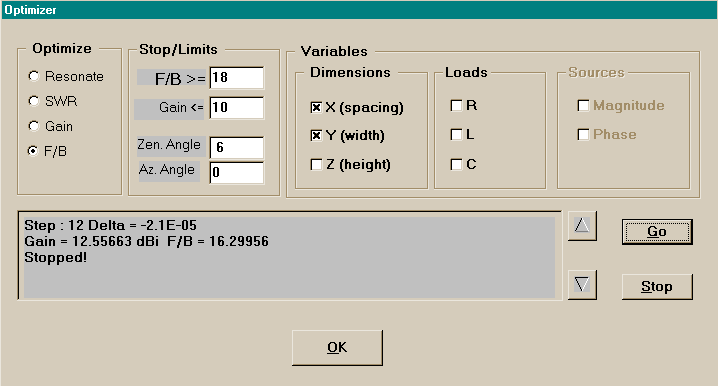NEC4WIN95 Review
Madjid Boukri, VE2GMI, has been pursuing such developments in the Windows 95 environment. His latest release, NEC4WIN95, makes use of many of the graphical and user-friendly facets of the operating system, and further developments are in the wind.

Antenna modeling software begins with a geometry module, where the user enters in the coordinates of his or her straight-line model of the antenna. As the figure show, NEC4WIN95 uses a spreadsheet layout for key entries. For each wire of the overall antenna, the user adds a line (or inserts one, if specific placement in the list is needed). Then it is a matter of filling in the X, Y, and Z values, along with the number of segments.
There are special pull-down boxes for drag-and-drop placement of the sources, with both voltage and current sources available. A similar drag- and-drop procedure also places loads, with an additional box for easy entry of the load R, L, and C values or the R +/-jX values, as appropriate. These boxes make relatively easy work of modeling traps as well as standard reactive loads. Additional boxes permit setting the frequency and ground parameters for the model. As with every modeling program, users should thoroughly familiarize themselves with what each parameter means to the modeling process. Antennas are not just assemblies of copper or aluminum. They exist within a set of conditions, and the assembly and the conditions together determine in what way the antenna does its job.
Since everything depends upon running the completed model through the calculational core, there is a special “Calculation” button which opens a dialogue box for setting those parameters. As soon as the calculations are complete, the main screen–blank until this point–displays the basic antenna model data.
Although most antenna modeling programs produce only data tables out of their cores, commercial implementations rely heavily on graphical pattern plotting to aid users in understanding the potential performance of the antenna being modeled. NEC4WIN95 is no exception, with provision for antenna viewing, 2-dimensional azimuth and elevation pattern plotting, and special 3-dimensional features. Viewing the antenna has two main uses. The first is before the antenna is run in order to check the geometry for errors. After the run, the antenna can be check visually for current levels or placed within a plot for evaluating performance.

Pattern plotting is especially sharp in the Windows environment, as the sample azimuth display shows. One of the unique features of NEC4WIN95 appears in the 2-dimensional plot displays: the listing of the most-wanted MININEC output data, including the source impedance and 50-Ohm SWR, height, ground characteristics, gain, and front-to-back ratio (only in azimuth plots). Moreover, the listing shows the angular location of pattern lobes. This feature takes the guess work and data-file hunting out of locating the many lobes above the first for horizontal antennas placed over ground. In addition, complex azimuth patterns, such as the pattern on 10 meters of a 135′ center-fed doublet, become clear enough to use for detailed planning of the antenna position in the real world.
A second unique feature of NEC4WIN95 is the ability to change the antenna height directly from within the plotting section of the program. While viewing a plot at one height, you may change the height and direct the program to recalculate the pattern for that height without running the antenna calculations from scratch. Exploring changes in the antenna pattern with changes in height becomes a routine venture in the modeling process.
One of the more recent additions to the program is the ability to create multi-color 3-dimensional plots while still showing the antenna geometry within it. In fact, the user can change plot size independently of antenna size so that the antenna wires still show, as in the sample Yagi plot.

A standard antenna hardly scratches the surface of plotting capabilities. Madjid’s own favorite display seems to be a modeled compact car and fender-mounted vertical under the umbrella of the 3-D pattern. How the auto shape (relative to the antenna position) and the pattern undulations relate to each other becomes instantly apparent.
The program also provides for 2-dimensional antenna views with segmentation and segment numbers shown for reference. This feature aids in error detection. Views, whether 2-D or 3-D can be rotated by cursor key or by mouse to ensure clarity of detail.
Even more recent has been the development of an optimizer module for NEC4WIN95. It operates directly on the user-entered numeric values for the antenna wires. For stepped diameter models, the user can lock down interior element junctions so that the optimizer works only on selected end sections.

As shown in the figure, the optimization dialogue lets the user select the feature to optimize, along with stop-limits for the process. Only the variables selected play a role in the process. As the box shows, it is possible to resonate not only an antenna, but as well its traps.
Tests of the optimizing process found it effective in reoptimizing some standard Yagi designs that I had purposely “unoptimized.” In some case, it is necessary to restart the optimizing routine once it has stopped itself– several runs may be needed to enure that all possibilities have been examined. However, the runs are rapid.
One of the most difficult transitions for former DOS users to make is to get used to using the extensive on-line help system that Windows makes readily available. The “manual” for NEC4WIN95 resides in its help screens, which provide succinct step-by-step procedures along the way. Users who would like a handy manual to consult when not using the program can simply print out each of the help screens, organizing the sheets for ready reading and reference.
Since bringing out the first version of NEC4WIN in the Windows 3 environment, Madjid has never viewed the program as a finished project. The conversion to the 32-bit Windows 95 environment, the optimization module, and the 3-dimension pattern and antenna viewing are only the most visible facets of VE2GMI’s development program. Source and load specification, along with a large number of individual features, have also benefitted from improvements along the way.
The future is likely to see additional enhancements of the program and its packaging. Under consideration is a separate manual to provide additional guidance to first time modelers in their initial steps through the program. (Hopefully, the “Antenna Modeling” column found elsewhere in antenneX will go some distance in achieving the same goal, despite not being program-specific.) Moreover, as hinted at in one of the graphics at the Orion web site, the Windows 95 environment may permit breaking the segment limitation inherent in the original MININEC core, thus allowing the MININEC user to model structures of much greater complexity.
To track the developments in NEC4WIN95, interested modelers should stay tuned to VE2GMI’s web site: <http://www.cam.org/~mboukri> – Sadly Another site now gone.
The current price of NEC4WIN95 is US $60, which includes the entire 32 bit program on diskettes, free support, and free upgrades. These upgrades include all future improvements made to the optimizer. One of the advantages of using the internet as a medium of exchange is that e-mail often yields more rapid help than phone calls to a vendor line that always seems either busy or on hold.
As a MININEC-based modeling program, NEC4WIN95 is subject to the limitations inherent in the calculating core, including the ground system that is reliable only when horizontal antennas are at heights above 0.2 wavelength. However, those limitations notwithstanding, the foreseeable future in the development of method-of-moments modeling cores suggests that MININEC will have a continuing place in antenna work, not only because it can deal with some situations that press NEC beyond its limits, but as well because MININEC produces accurate results when held within its own limits.
As Windows moves from 95 to 98 and beyond, debate has developed over whether older DOS-based programs will run effectively on the evolving PC operating systems. NEC4WIN95 has stepped above the debate by being programmed directly for the new environment. It is likely to become a staple among modeling programs used by hams worldwide.
Originally posted on the AntennaX Online Magazine by L. B. Cebik, W4RNL
Last Updated : 25th April 2024
